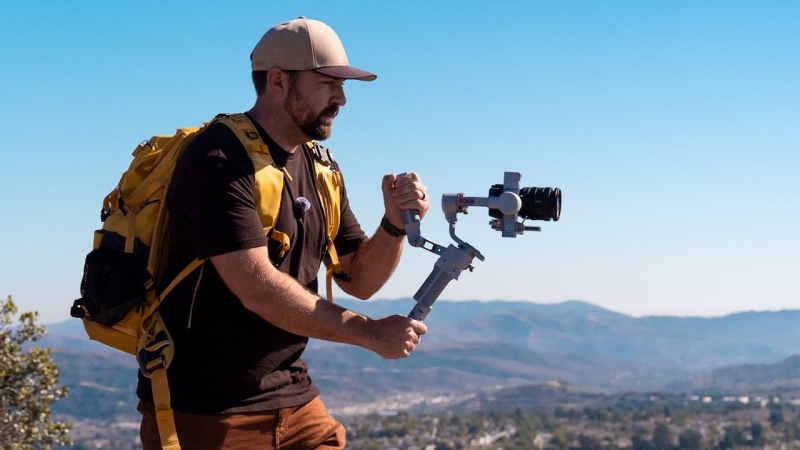Contents
When you first buy a gimbal, you envision yourself shooting epic vistas, like the opening scenes of your favourite movie. The footage will be buttery smooth, and of course, you can emulate both a Steadicam and a crane; why not? However, the reality is that even a mobile phone gimbal requires a little practice, and it becomes steadily harder the larger you go.
Hand placement is integral to achieving smooth footage, and in this video, Jeven Dovey suggests three different ways that you can achieve smoother footage more comfortably on the DJI RS4 Mini.
1. The Classic Lollipop Hold
Can anyone say ‘kid in a sweet shop’? That’s usually how you feel when you first unbox your new gear, only to quickly realise that you actually need to learn how to use it! So keeping things simple is good to begin with. The most straightforward way to use a gimbal is in the upright “lollipop” position. Jeven recommends starting with the bare minimum setup with no additional handles or tripods, just the gimbal itself.
- How to Hold It: Grip the gimbal vertically, keeping the screen visible for easy monitoring.
- Movement: Walk forwards, backwards, or pan smoothly while keeping both hands on the gimbal for stability.
- Best For: Basic tracking shots, walking sequences, or simple pans.
Jeven notes that while this method works, adding a briefcase handle (an optional gimbal accessory, not literally a handle from a suitcase) makes a huge difference. With one hand on the handle and the other on the battery grip, the gimbal becomes far more stable.
“Having two points of contact is a game-changer,” Jeven says. “Whether you’re sliding, walking, or following a subject, the extra grip helps eliminate shaky movements.”
For even more control, he suggests attaching the tripod at the bottom. This extends the grip points, allowing for smoother orbits and more controlled movements.
2. The Flashlight Mode (Horizontal Grip)
If you want dynamic, cinematic shots, and we all do, then the “flashlight” hold (where the gimbal is positioned horizontally) opens up new creative possibilities.
- How to Hold It: Extend the gimbal straight out, as if holding a flashlight.
- Movement: Walk forwards or backwards while keeping the camera level.
- Best For: Tracking shots, low-angle movements, and immersive POV footage.
Jeven again emphasizes the importance of the briefcase handle in this mode. Without it, holding the gimbal horizontally can strain the wrists. But with the handle attached, one hand rests on top while the other steadies the tripod, making movements fluid and natural.
This is also how you get those epic low-angle shots,” he explains. By crouching and holding the gimbal near the ground, filmmakers can capture dramatic foreground elements while maintaining stability.
Pro Tip:
Always shoot in Pan Follow (PF) mode when switching between upright and horizontal holds. This ensures the camera stays level rather than tilting unexpectedly.
3. The Underslung Mode (Upside-Down Hold)
For ultra-low perspectives or unique angles, flipping the gimbal upside down—known as the “underslung” position—can be incredibly effective.
- How to Hold It: Rotate the gimbal so the camera hangs below the handle.
- Movement: Walk smoothly or raise/lower the gimbal for dynamic height shifts.
- Best For: Ground-level shots, creative transitions, and dramatic reveals.
Jeven warns that this technique requires some caution: “With wider lenses, you might see the front motor in the frame if you pan too far. But with a 16mm or tighter, you’ll have enough clearance.”
It’s All About Body Control
Ultimately it’s all about moving smoothly throughout your whole body, beyond just holding the gimbal. Jeven stresses the importance of body mechanics for smooth footage:
- Avoid jerky motions by adjusting the gimbal’s responsiveness. A slower, smoother setting (around 15 speed) helps create cinematic movements.
- Use your whole body, not just your wrists, when panning or tilting. Shifting your weight ensures fluid motion.
- Practice different stances: Squatting, side-stepping, and controlled walking all contribute to better shots.
“Filming with a gimbal is like dancing,” Jeven says. “You have to move with intention, whether you’re tracking a fitness routine or gliding through a real estate shoot.”
FInal Thoughts
While a gimbal is an excellent piece of filmmaking equipment that certainly can help you to create smooth footage, it isn’t the be all and end all. There might be another tool that will actually work just as well, if not better for the shot that you’re hoping to film, like shooting handheld to increase the tension in a scene.
In the end, a gimbal is only as good as the person operating it. However, by mastering these three holds, photographers and videographers can unlock new levels of creativity.
Jeven’s best advice? Experiment, practice, and watch gimbal move tutorials. The more you play with it, the more natural it becomes.”
Watch the whole video below to see how he shoots smooth footage:

